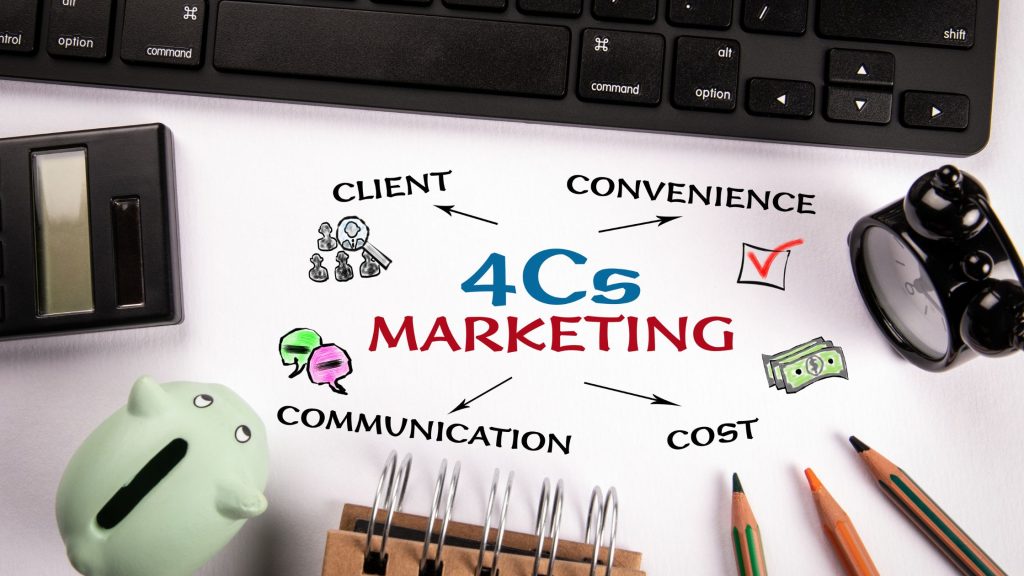Marketing is a dynamic field that requires a thorough understanding of various concepts and frameworks to develop effective strategies. Among the most fundamental frameworks are the 4Ps and 4Cs of marketing. These frameworks provide a comprehensive approach to understanding the marketing mix and customer value proposition.
Join us as we will into the 4Ps and 4Cs, exploring their components and discussing their significance in contemporary marketing practices.
| Quick Answer |
| The 4Ps of marketing (product, price, place, and promotion) and the 4Cs of marketing (customer, cost, convenience, and communication) are two frameworks that help marketers develop effective strategies. The 4Ps focus on the company’s perspective, while the 4Cs emphasize the customer’s perspective. By integrating these frameworks, marketers can balance business objectives and customer needs, create value, and build strong customer relationships to drive satisfaction and success. |
What is a marketing matrix?
A marketing matrix is a framework that assists marketers in determining the optimal balance of marketing campaigns. It depicts the relationship between product, price, location, and promotion for specific business objectives.
Depending on what you want to measure, the matrix can be created in a variety of ways. It is frequently used to assist marketers in determining which aspects want greater attention and which require more development. A two-dimensional matrix will have four separate components, which can be divided into the 4Ps and 4Cs of marketing.
The 4Ps of Marketing

The 4Ps of marketing, also known as the marketing mix, were first introduced by E. Jerome McCarthy in the 1960s. They represent four key elements that businesses need to consider when designing and implementing marketing strategies. The 4Ps are:
- Product.
- Price.
- Place
- Promotion.
1. Product
This deals with goods or services that are offered by an organization to address the needs of the target market they aim at. It encompasses the physical attributes, features, quality, packaging, branding, and even intangible aspects such as warranties and customer support.
Companies must carefully analyze their target customers’ preferences and design products that align with their needs and desires. Product development, innovation, and differentiation are essential considerations in this element of the marketing mix.
2. Price
Price refers to the amount of money customers are willing to pay for a product or service. It is very important for an organization to have the right pricing policy as this helps the organization to build profit and competition in the market.
Factors influencing pricing decisions include production costs, competition, customer perceptions of value, and overall marketing objectives. Companies can choose various pricing strategies, such as cost-based pricing, value-based pricing, penetration pricing, or skimming pricing, depending on their target market and business goals.
3. Place
Place, also known as distribution, focuses on getting the product to the right customers at the right time and in the right location. This element involves decisions regarding distribution channels, logistics, inventory management, and retail partnerships.
Companies must analyze their target customers’ buying habits and preferences to determine the most appropriate distribution strategies. These strategies may include direct sales, online channels, wholesalers, retailers, or a combination of these options.
4. Promotion
This deals with the company’s actions to advertise the products and services it offers to the targeted market.
Thus, the following are very essential for promotion:
- Advertising.
- Public relations.
- Sales promotions.
- Personal selling.
- Digital marketing efforts.
The aim is to create awareness, generate interest, and persuade customers to make a purchase. Effective promotion strategies consider the target audience, their media consumption habits, and the most impactful channels to reach and engage with them.
While the 4Ps provide a solid foundation for marketing strategies, they primarily focus on the company’s perspective.
However, the marketing landscape has evolved, and customer-centric approaches have gained prominence. This shift has led to the emergence of the 4Cs of marketing, which place the customer at the core of the marketing process.
The 4Cs of Marketing

The 4Cs framework, introduced by Robert Lauterborn in the late 20th century, offers a customer-oriented perspective to complement the 4Ps. It emphasizes understanding and delivering customer value as the driving force behind successful marketing efforts. The 4Cs consist of Customer, Cost, Convenience, and Communication.
1. Customer
The customer is at the center of the 4Cs framework. Understanding the target customers’ needs, preferences, behaviors, and aspirations is essential for creating value and building strong customer relationships.
Marketers need to conduct market research, gather customer insights, and segment the market to identify specific customer groups. By truly understanding their customers, companies can tailor their products, services, and marketing efforts to meet their expectations and create a meaningful connection.
2. Cost
Cost refers to more than just the price of the product or service. It encompasses the entire cost associated with acquiring, owning, and using the product or service. Customers evaluate not only the monetary price but also factors such as time, effort, and psychological costs.
Marketers need to consider the overall value proposition their offering provides to customers. This includes factors like product quality, durability, convenience, after-sales support, and the overall cost-effectiveness of the product or service. By delivering superior value relative to the cost, companies can attract and retain customers.
3. Convenience
Convenience refers to the ease and accessibility of obtaining and using the product or service. In today’s fast-paced world, customers value convenience highly. Marketers need to ensure that their offerings are readily available, accessible through various channels, and easy to use.
This may involve factors such as online purchasing options, efficient delivery, user-friendly interfaces, and excellent customer service. By focusing on convenience, companies can enhance customer satisfaction and loyalty.
4. Communication
This emphasizes why an organization should engage and build good relationships with customers. Effective communication involves more than just promotional messages; it involves creating meaningful interactions and dialogue with customers.
Marketers need to establish open channels of communication, listen to customer feedback, address concerns promptly, and personalize their communications. With the advent of social media and digital platforms, companies have more opportunities than ever to engage with their customers and foster two-way communication.
The 4Cs framework recognizes the shift in power from companies to customers and underscores the significance of customer value and satisfaction in driving successful marketing strategies. By adopting a customer-centric approach, companies can create superior customer experiences, build strong brand loyalty, and achieve long-term success.
Integrating the 4Ps and 4Cs
While the 4Ps and 4Cs frameworks have distinct focuses, they are not mutually exclusive. In fact, they complement each other and can be integrated to create comprehensive marketing strategies.
By considering both the company’s perspective (4Ps) and the customer’s perspective (4Cs), marketers can strike a balance between their business goals and customer needs. Successful marketing strategies involve aligning the product, price, place, and promotion elements with the customer, cost, convenience, and communication elements.
It is essential for marketers to continuously evaluate and adapt their marketing mix and customer-centric strategies based on evolving market dynamics and customer expectations. The 4Ps and 4Cs frameworks serve as valuable tools to guide marketers in developing effective marketing strategies, driving customer satisfaction, and achieving sustainable business growth in today’s dynamic and competitive marketplace.
Difference between 4Ps & 4Cs of Marketing

The key distinction between a 4Ps and a 4Cs is that while both marketing metrics reflect four different areas that marketers must evaluate, the main difference is what each aspect is defined as. The 4Ps of product, pricing, place, and promotion refer to the products offered by the company and how they are delivered to customers.
The 4Cs stand for stakeholders, costs, communication, and distribution channels, all of which are important parts of how your organization operates. They can help you obtain a better idea of what you should be focusing on when optimizing your marketing strategy.
Marketers will have a better understanding of how to enhance their marketing strategy if they understand the differences between the two matrices and the components they measure. This is due to the fact that each takes a different style of thinking based on what you are attempting to accomplish.
What are the Factors that Influence 4Ps and 4Cs?
Let’s take a look at some possible factors that could influence the 4Ps and 4Cs, as there are several of them to be considered. These factors include:
Needs and Wants of Customers
One example is the increased demand for organic products, which has resulted in the increased popularity of such goods and services. Pressures from competitors. This relates to how other firms may influence your 4Ps and 4Cs by offering comparable products at lower rates or providing better customer service than you do.
Changes Within a Company Division
This includes new technological breakthroughs that, if compatible with such devices, can improve your product. Changes to your business structure may also be included, allowing you to expand within the industry.
Government Laws and Policies
These can have an impact on everything from fees and taxes to labor conditions and import restrictions. Such elements play a significant role in determining how successful a business will be, as they can have a significant impact on the decisions that a business can make.
READ ALSO:
- How to Print Gridlines in Excel Online
- How to Import Data into Excel Online
- How to get Excel Certified Online
- How to Access Excel Online
Frequently Asked Questions
The 4Ps provide a framework for businesses to address critical aspects of their marketing strategies. They help define the product offering, determine pricing strategies, identify distribution channels, and plan promotional activities.
The 4Ps play a crucial role in influencing customer behavior.
Product attributes and quality impact customer preferences, pricing affects their perception of value, place determines accessibility, and effective promotion creates awareness and interest.
The 4Cs place the customer at the core of marketing efforts, whereas the 4Ps primarily focus on the company’s perspective. The 4Cs emphasize understanding customer needs, providing cost-effective solutions, offering convenience, and engaging in effective communication.
To incorporate the 4Cs, companies need to deeply understand their target customers, analyze their preferences, and tailor products and services to meet their needs. They should consider the overall cost-effectiveness, ensure convenience in purchasing and usage, and engage in effective communication and relationship-building with customers.
Wrap up
In conclusion, the 4Ps and 4Cs of marketing provide comprehensive frameworks for developing successful marketing strategies. The 4Ps focus on the company’s perspective, addressing product, price, place, and promotion.
The 4Cs, on the other hand, emphasize the customer’s perspective, considering customer, cost, convenience, and communication. Integrating these frameworks enables marketers to strike a balance between business objectives and customer needs, creating value, and building strong customer relationships.
By leveraging these frameworks effectively, companies can drive customer satisfaction, loyalty, and long-term success in the ever-evolving world of marketing.


